Perhaps the most fundamental question to answer when discussing palm pruning is what should a healthy, properly pruned palm look like? Contrary to popular belief, the palm in Figure 1 is not a properly pruned palm. It provides little shade, is unattractive, and will be weaker than a full-canopied palm like the one in Figure 2. A properly fertilized and pruned palm like the one in Figure 2 should have a round canopy with green leaves right down to the bottom. Consumers must be educated that palms are supposed to have round crowns, not feather-duster crowns.
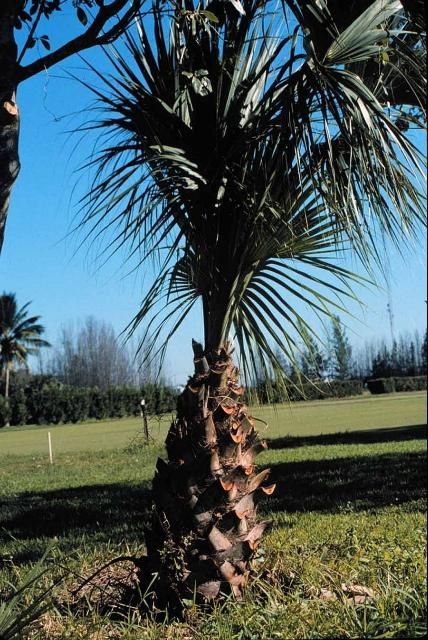
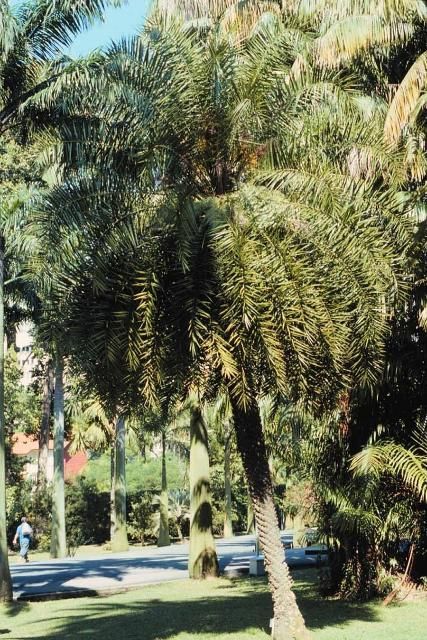
Secondly, not all palms require pruning. There is a large group of palms that have crownshafts—a region of smooth, usually green, tightly clasping leaf bases at the top of the gray trunk (Figure 3). Palms with crownshafts should never need pruning if properly fertilized. A healthy old leaf will be completely green one day, completely orange-brown the second day (Figure 4), and completely brown the third day, when it should fall off by itself. This is natural senescence. Half-dead old leaves that remain on the palm for months at a time are usually deficient in potassium (K) (https://edis.ifas.ufl.edu/ep269) (Figure 5) and should be fertilized (https://edis.ifas.ufl.edu/ep261) to prevent this problem.
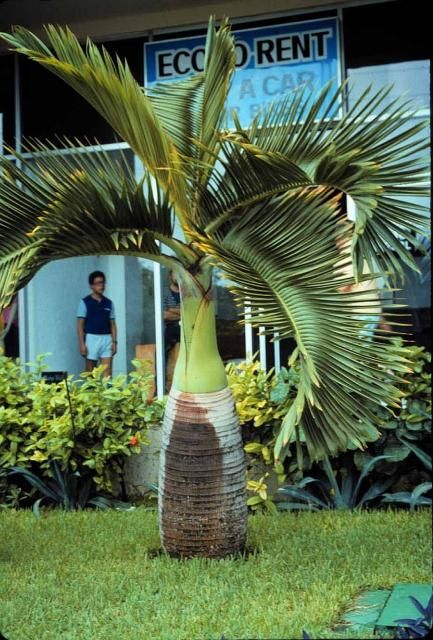
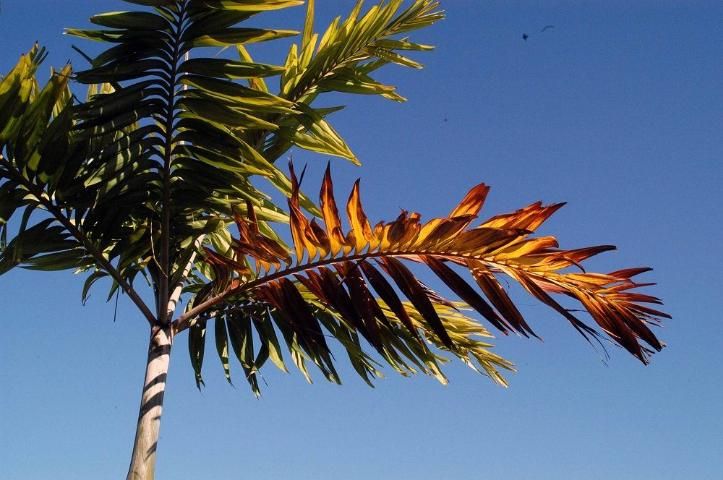
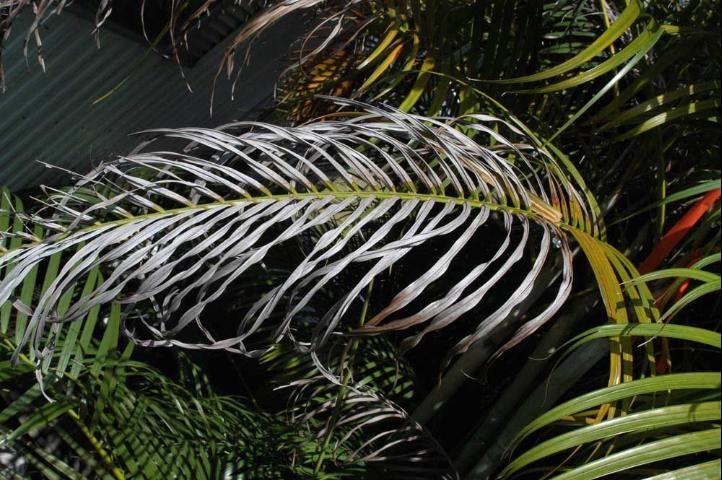
Old leaves in palms without crownshafts senesce similarly to those with crownshafts, but dead leaves may have to be pulled or cut off manually (Figure 6). They usually drop down and hang against the trunk when they die, whereas K-deficient leaves usually remain in their normal position within the canopy.
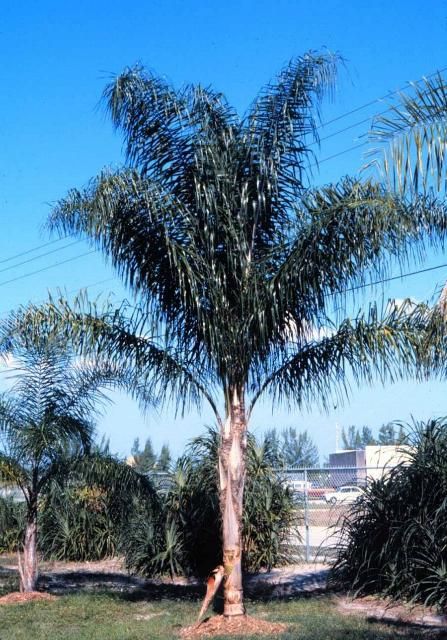
Effects of pruning on palms
Pruning, or more importantly, excessive pruning, can affect palms in a number of ways. If palms are overpruned, the reduction in canopy size results in reduced photosynthetic capacity. In the short term, some studies have shown that overpruning can result in greater leaf production rates, but the resulting leaves were smaller in size than those on unpruned palms (Endress et al. 2004; Mendoza et al. 1987; Oyama and Mendoza 1990). If this practice is repeated frequently, the palm may also develop a smaller trunk diameter (Figure 7).
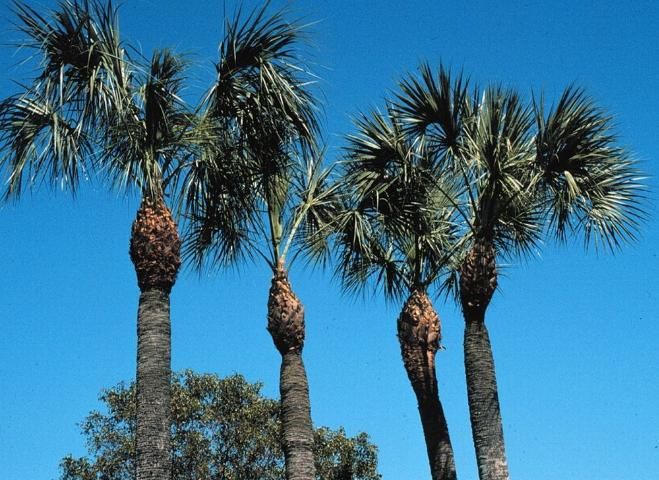
Pruning old K-deficient leaves can also impact palm health. Potassium, like nitrogen and magnesium, is a mobile element within the palm. Thus, symptoms occur first on the oldest leaves, as these are depleted of their K in order to sustain growth of the new leaves. The oldest leaf (on the left side) in the K-deficient spindle palm (Hyophorbe verschafeltii) shown in Figure 8 shows necrosis and frizzling of most leaflets, but the rachis and the basal portion of most leaflets remain alive. The next oldest leaf (on right) shows no necrosis but has extensive orange translucent spotting on its leaflets. The youngest leaf is completely symptom free. If these older discolored leaves are removed, the palm then removes K from the next leaves up within the canopy that are currently green and symptom free. Repeated pruning of K-deficient older leaves has been shown to reduce the number of green, symptom-free leaves within the canopy (Broschat 1994) and, in severely K-deficient palms, is known to accelerate the rate of decline leading to death of the palm.

Some diseases, such as fusarium wilt of Canary Island date palm (Phoenix canariensis) (https://edis.ifas.ufl.edu/pp139) (Figure 9), are known to be spread by pruning with infested tools (Elliott et al., 2004). Tools used to prune infected palms will be covered with a residue containing fungal material. If this tool is then used to prune living leaves on a healthy palm, the fungus will be transferred in the process. When pruning these palms, tools should be soaked in a disinfectant solution for 5 minutes before using them on another palm. Better yet, cut down the infected palm as soon as the disease is noticed to reduce the chances of spreading it to other palms. This is also a good reason not to prune off living older leaves to achieve the so-called "pineapple" effect on Canary Island date palms. Freshly cut living leaf bases release volatile chemicals that attract palm weevils, a serious insect pest of this palm (https://edis.ifas.ufl.edu/IN139).
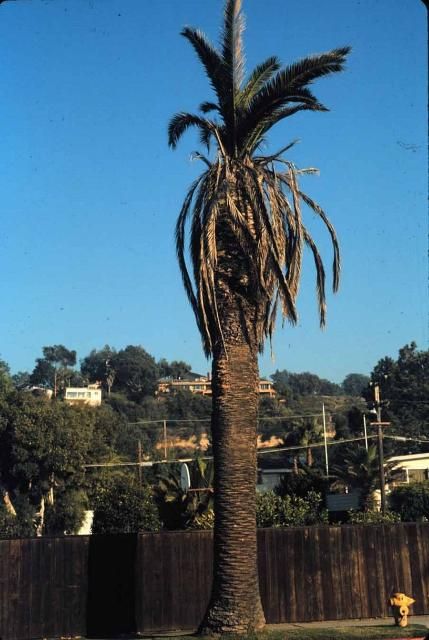
Removal of old palm leaf skirts such as those found on Mexican fan palms (Figure 10) can remove hiding places for rats, snakes, scorpions, and other desirable or not so desirable wildlife. Note that the skirt of dead leaves is beginning to fall off some of the palms in Figure 10. In Florida, Mexican fan palms about 30 feet tall or less typically retain their dead leaves or leaf bases, but within a year or so of reaching this size, all of these old leaves will begin to drop off by themselves (Figure 11). After that, these palms become mostly self-cleaning and should not have to be pruned manually.
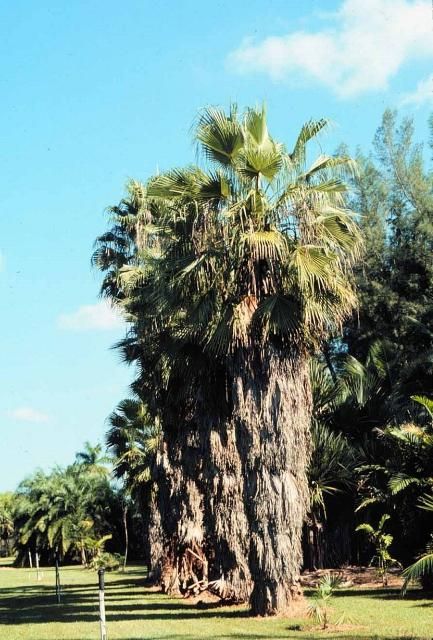
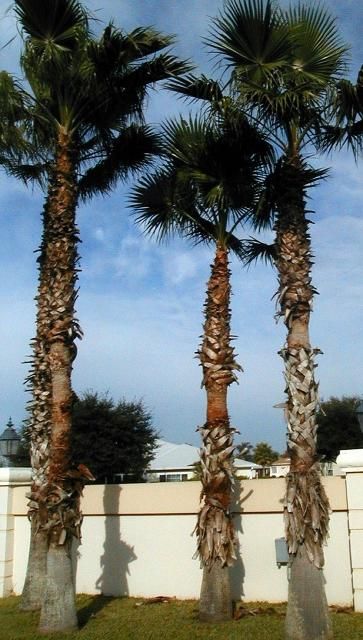
Although not documented scientifically, there are anecdotal observations that overpruned palms fare more poorly in cold weather events than those with fuller canopies. The additional leaves or leaf bases can provide insulation to the bud or meristem. After cold weather events, it is recommended that cold-damaged leaves not be pruned off until after the threat of additional cold weather (https://edis.ifas.ufl.edu/mg318) has passed.
Traditionally, arborists have been asked to prune palms prior to the arrival of hurricane season. "Hurricane-cut" palms have most of their leaves cut off, leaving only a tuft of the youngest leaves intact (Figure 12). The intent was to reduce wind resistance in the palm, thereby protecting it from wind damage. However, observations of palms after the severe hurricane seasons of 2004 and 2005 in Florida showed that these "hurricane-cut" palms were more likely to have their crowns snapped off than those with fuller crowns (Figures 13 and 14). This may be because the youngest leaves left on these overpruned palms have not hardened off to the extent that older leaves have and lack the support of the older leaf bases (Pfalzgraf 2000). These observations are supported by research on African oil palms (Elaeis guineensis) (Calvez 1976; Chan and Duckett 1978). There is no evidence, however, that reduced trunk caliper reduces palm trunk strength.
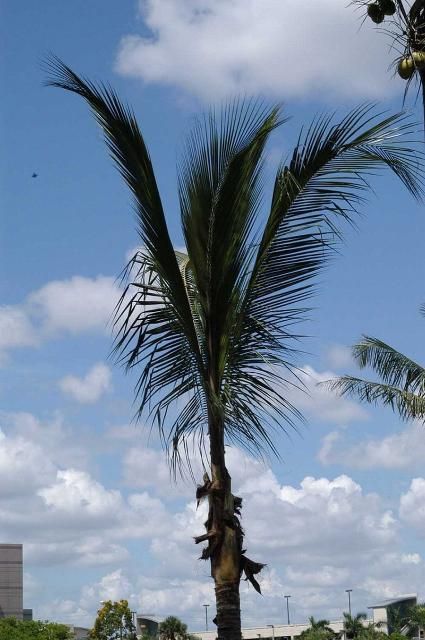
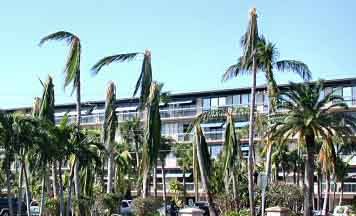
Credit: D. Caldwell, UF/IFAS
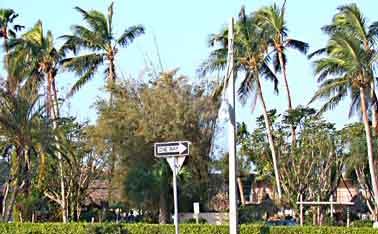
Credit: D. Caldwell, UF/IFAS
What should be pruned from palms?
Removal of completely dead leaves and flower and fruit stalks from palms is never a problem (Figure 15). However, half-dead or discolored lower leaves are a symptom of K or other nutrient deficiencies (https://edis.ifas.ufl.edu/ep273) (Fig. 8). Despite their unattractive appearance, these leaves should be left on the palm as they are providing K in the absence of sufficient K in the soil. It is preferable to treat the K deficiency with effective fertilizers (https://edis.ifas.ufl.edu/ep261) to prevent these older leaves from becoming deficient than to cut them off, only to have the symptoms return.
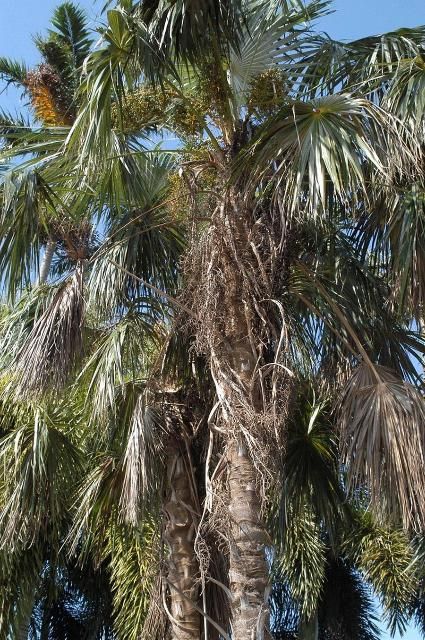
If petioles of otherwise healthy leaves have become severely kinked or damaged due to wind (Figure 16) or other mechanical injuries, there is no problem with removing the affected leaves. However, if a few kinked leaves are all that remain on a palm following a severe windstorm, then it may be advisable to retain these damaged leaves as a source of photosynthates for the palm until new leaves can be produced.
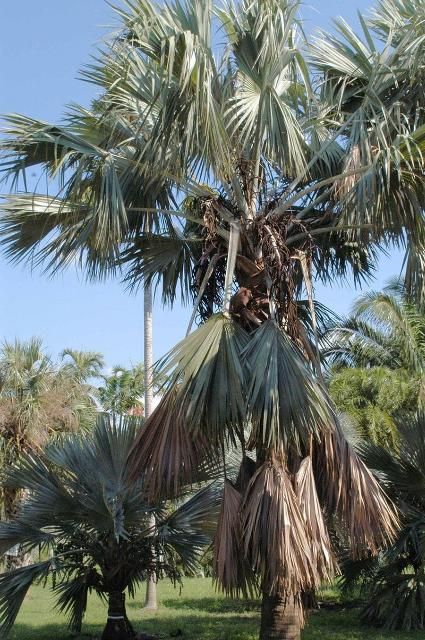
There is no evidence that removal of living flower or fruit stalks (Figures 17 and 18) causes any harm to palms. In fact, studies have shown that removal of flower stalks results in increased leaf production rates since carbohydrates that would have been diverted into the production of flowers and fruits are now available for leaf production. Removal of flower stalks also prevents the production and drop of messy fruit that can eventually sprout into unwanted seedlings. In public areas, coconut palm fruit drop is a major liability concern, and it is much easier to remove small flower stalks than heavy clusters of fruit (Figure 19).

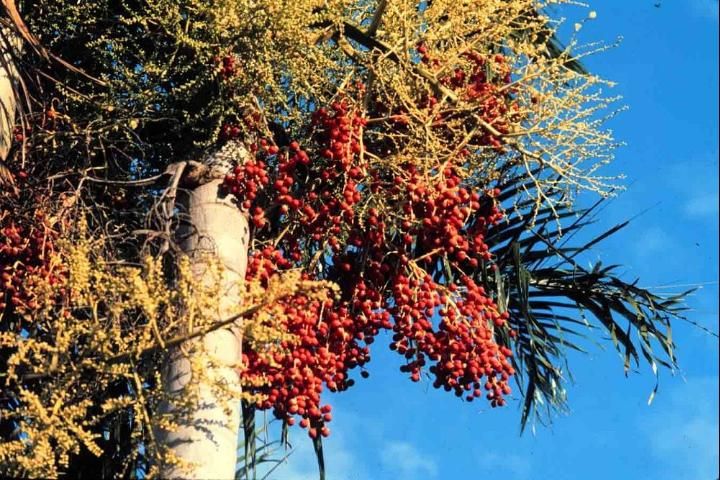
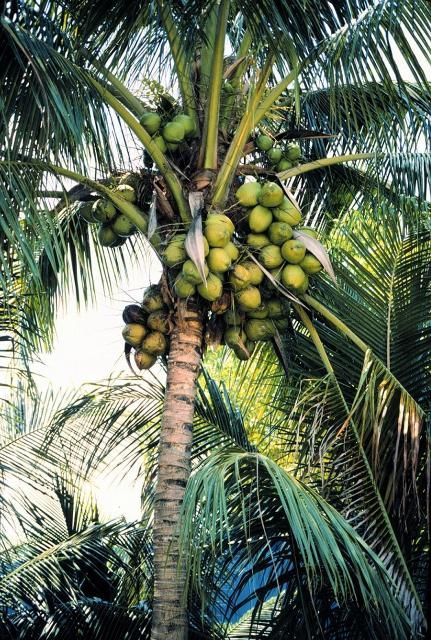
When should palms be pruned?
Palm pruning is done primarily for aesthetic purposes. From the palm's perspective, there is no one time of the year that is better than another. Pruning dead leaves prior to hurricane season may reduce the chances that these easily detached leaves will become missiles in a storm. Ideally, a dead leaf would be pruned whenever it appears on a palm, but that simply isn't practical unless the palm is located in your own yard and is small enough to be easily accessible with common pruning tools. Commercially, palms are pruned on a fixed schedule (e.g., yearly, semi-annually, etc.) or whenever the palm's appearance becomes unacceptable to the owner.
Can living leaves also be removed?
Experienced tree pruners have observed that the time until dead leaves reappear at the bottom of the canopy can be extended if they remove a number of living leaves from the bottom of a palm canopy while they are pruning off dead leaves. This is one of the justifications used for overpruning palms. This concept has merit except that one critical factor is missing in most Florida palms. With the exception of some Veitchia spp., solitaire palms (Ptychosperma elegans), Christmas palms (Adonidia merrillii), and a few other species, virtually all palms in the state of Florida are deficient in K. Potassium deficiency (https://edis.ifas.ufl.edu/ep269) causes premature leaf senescence; therefore, K-deficient palms are unable to support a full canopy of leaves. For example, the average 'Malayan Dwarf' coconut palm (Cocos nucifera) in South Florida retains about 13 leaves due to K deficiency (Figure 20). However, if properly fertilized and with no K deficiency, this species retains 26 or more leaves (Figure 21). The average Canary Island date palm retains about 65 leaves in South Florida due to K deficiency, but without K deficiency this species usually retains 130–150 leaves. Thus, most palms in Florida only have half of their normal number of leaves prior to pruning.
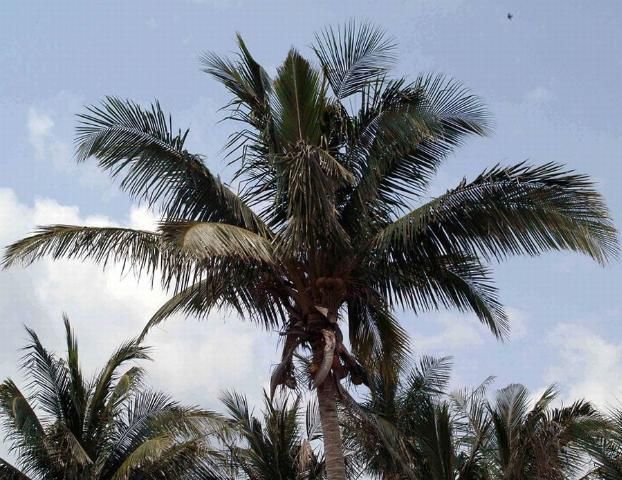
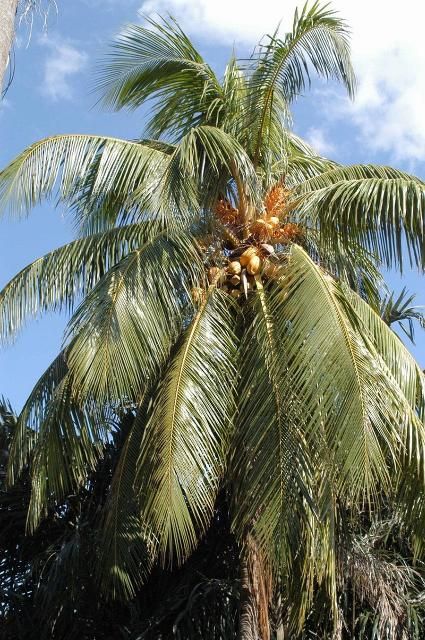
What is the relationship between K deficiency and pruning living leaves to "buy time" until the palm requires pruning again? If one starts with a K-sufficient palm with a full 360-degree canopy of healthy leaves, then, in theory, one could prune off as many living leaves from the bottom of the canopy as would be produced by the palm during the interval between prunings without ever seeing a single deficient or dead leaf on the palm during that time. In addition, the palm would never appear overpruned. For example, suppose one wishes to prune the leaves of a coconut palm on an annual basis, and this species produces an average of 10 leaves per year. If starting with a healthy, 26-leaved, full-canopied palm (Figure 21) and removing 10 leaves, the result would be a 16-leaf palm that looks similar to the one shown in Figure 22. During the following year, this palm would slowly add new leaves to the canopy until, at 12 months, it would again appear like the one in Figure 21. After about 13 months, the first dead leaf would appear at the bottom of the canopy, but since the palm would be repruned at 12 months, no dead leaves would ever appear on the palm. However, if one starts with a typical K-deficient South Florida coconut palm that only has 13 leaves (Figure 20) and removes a full year's production of 10 leaves, the result would be an overpruned 3-leaf palm (Figure 12) that, unfortunately, looks very familiar to most Floridians.
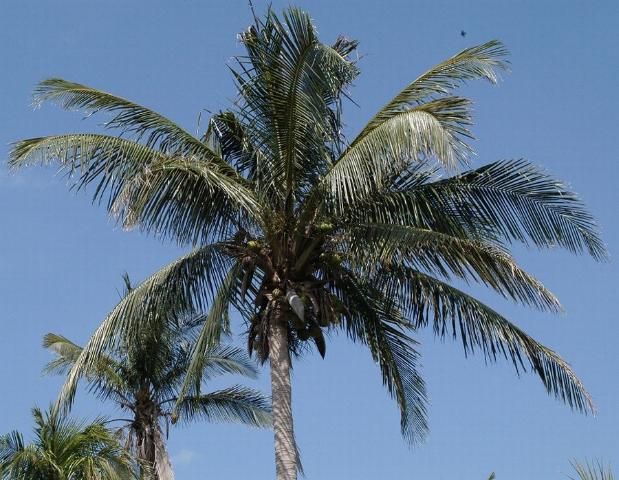
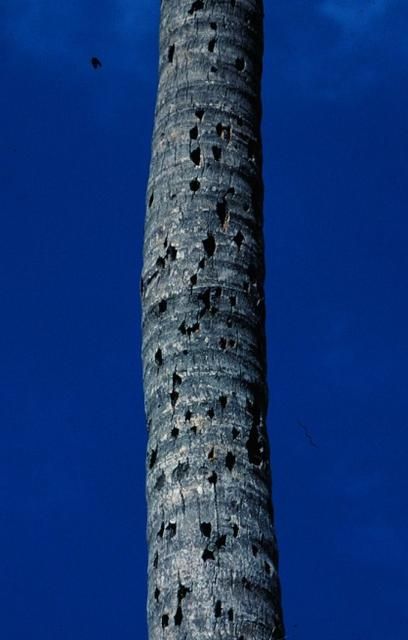
Because pruning K-deficient leaves is known to accelerate the rate of decline from K deficiency (Broschat 1994), and because those K-deficient older leaves are serving as a source of K for the palm in the absence of sufficient K in the soil, only completely dead leaves should be removed from these palms. However, if K deficiencies have been corrected, then one could safely remove as many green leaves from the bottom of the canopy as would be produced during the interval between prunings without affecting palm nutritional status.
How many leaves do palms produce per year? That number varies widely among species. Estimates of leaf production rates in South Florida for a few species are shown in Table 1. For species not listed, leaf production rates can easily be determined by cutting the tip off the spear leaf of a palm as a marker (or use another permanent system to mark the current spear leaf), waiting 12 months, and then counting the number of leaves above the marked leaf.
While the pruning regime discussed above is ideal for palms, it is unrealistic to expect that everyone will go to the effort and expense of correcting the K deficiency in their palms. It is a slow process that can take 3 years or longer. Thus, ANSI pruning standards for palms (ANSI 2001) state that no leaves with tips above the horizontal plane (9:00 and 3:00 positions on a clock face) should be removed. In Broward County, Florida, doing so is a civil offense and can result in a fine.
How to Remove Leaves
Leaves should be cut close to the trunk, but never cut into the trunk with a machete as this can result in wounds that have been shown to allow Thielaviopsis trunk rot (https://edis.ifas.ufl.edu/pp143), a lethal disease, to become established. For this reason, one should never pull off leaves that do not pull off easily. By pulling hard enough to eventually free these leaves, a small strip of trunk tissue will also tear off, again resulting in a wound that is readily colonized by Thielaviopsis paradoxa, the causal agent of Thielaviopsis trunk rot.
Finally, never use climbing spikes for pruning palm leaves, because wounds caused by the spikes will never heal (Figure 23) and can become entry sites for diseases, such as Thielaviopsis trunk rot, or attractants for serious insect pests, such as palm weevils (https://edis.ifas.ufl.edu/in139).
References
ANSI (American National Standards Institute). 2001. Tree, shrub, and other woody plant maintenance—standard practices (pruning). National Arborist Assoc., Manchester, NH.
Broschat, T.K. 1994. Removing potassium deficient leaves accelerates rate of decline in Phoenix roebelenii O'Brien. HortScience 29:823.
Calvez, C. 1976. Influences on oil palm yield of pruning at different levels. Oleagineux 1:57–58.
Chan, S.K., and J. E. Duckett. 1978. Crown fracture and palm type-initial findings. Planter, Kuala Lumpur 54:142–148.
Elliott, M.L., T.K. Broschat., J.Y. Uchida, and G.W. Simone. 2004. Compendium of ornamental palm diseases and disorders. Amer. Phytopath. Soc. Press, St. Paul, MN.
Endress, B.A., D.L. Gorchov, and M.B. Peterson. 2004. Harvest of the palm Chamaedorea radicalis, its effects on leaf production, and the implications for sustainable management. Conserv. Biol. 18:822–830.
Mendoza, A., D. Pinero, and J. Sarukhan. 1987. Effects of experimental defoliation on growth, reproduction, and survival of Astrocaryum mexicanum. J. Ecol. 75:545–554.
Oyama, K., and A. Mendoza. 1990. Effects of defoliation on growth, reproduction, and survival of a neotropical dioecious palm Chamaedorea tepejilote. Biotropica 22:119–123.
Pfalzgraf, K. 2000. On the pruning of palms. Palms 44:47–49.